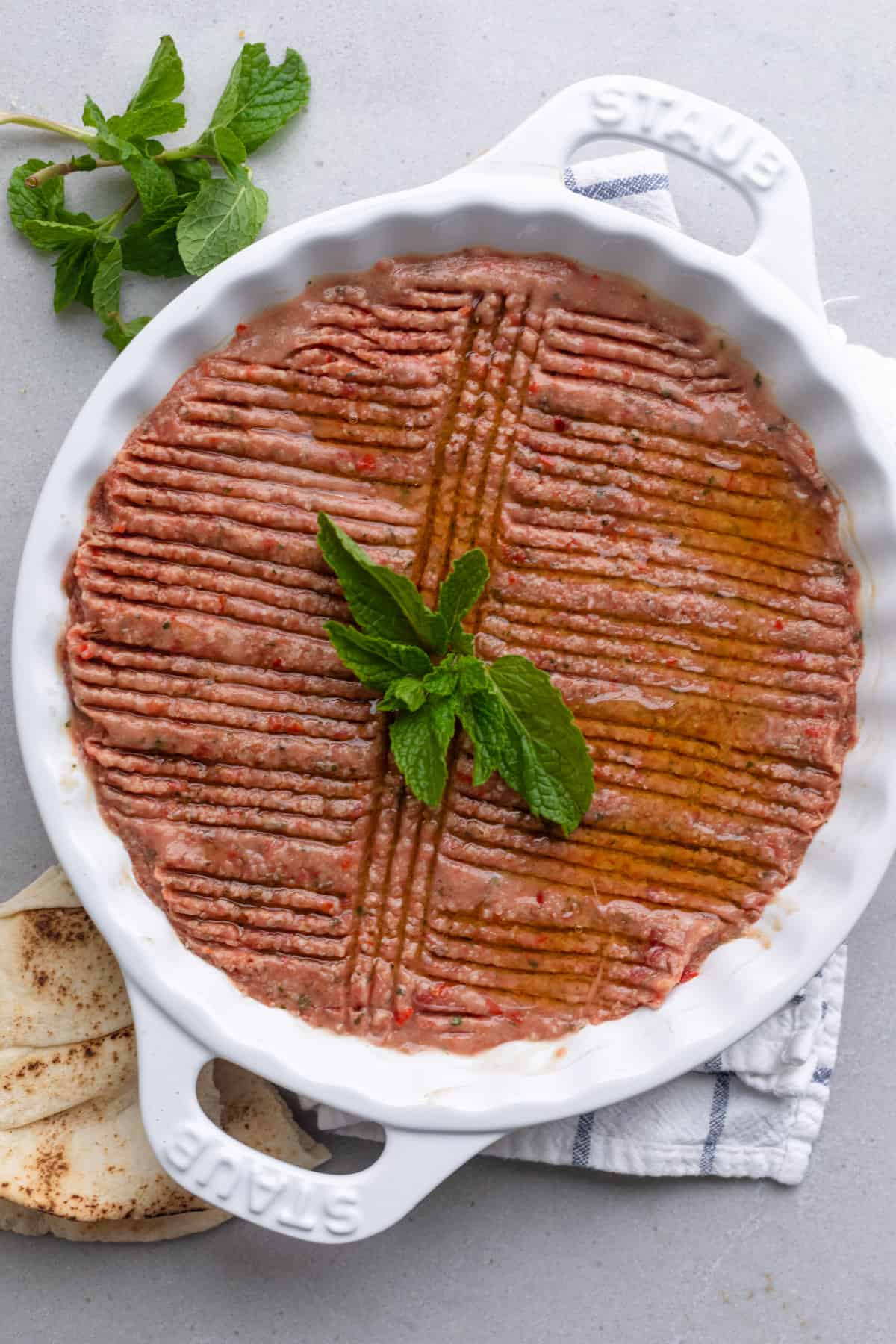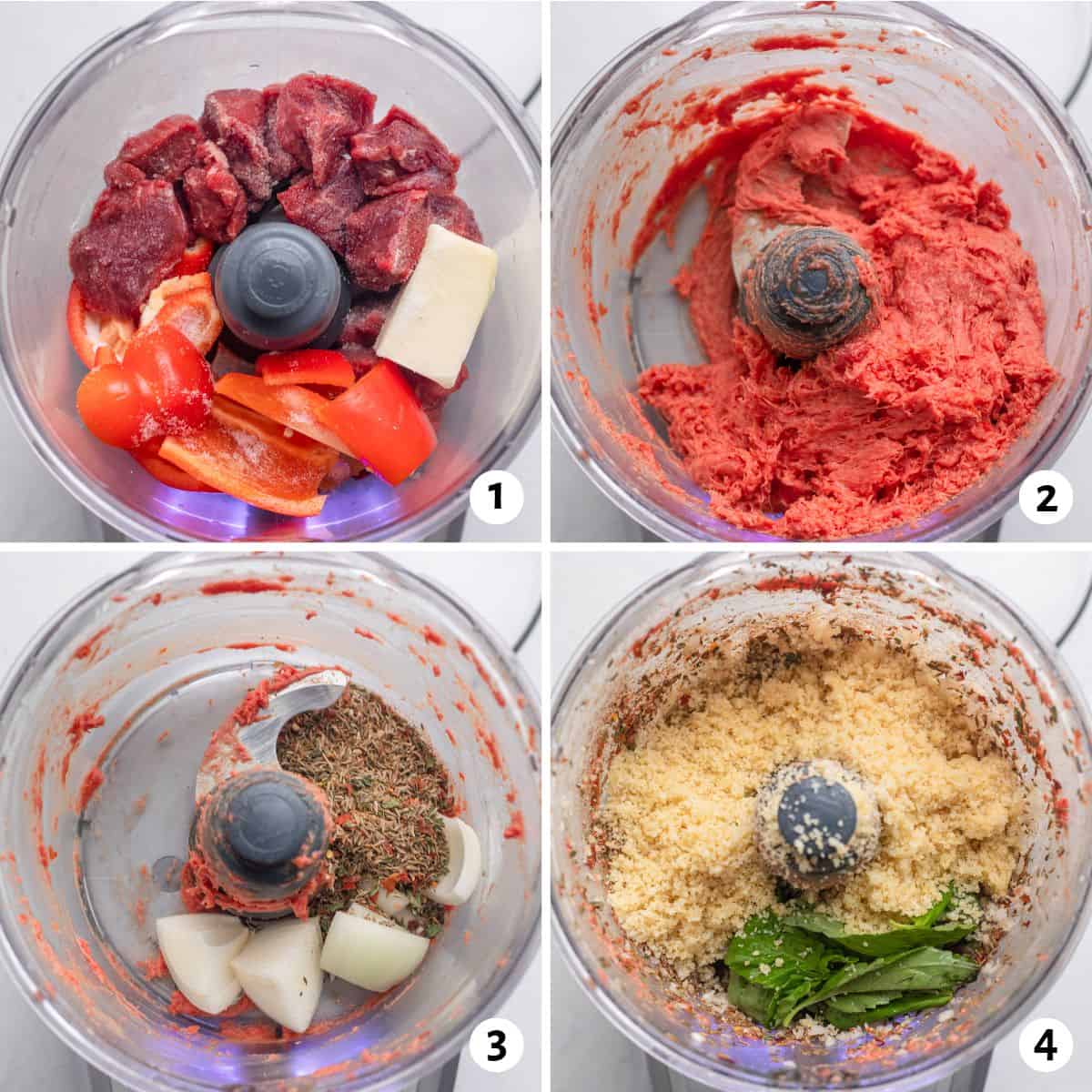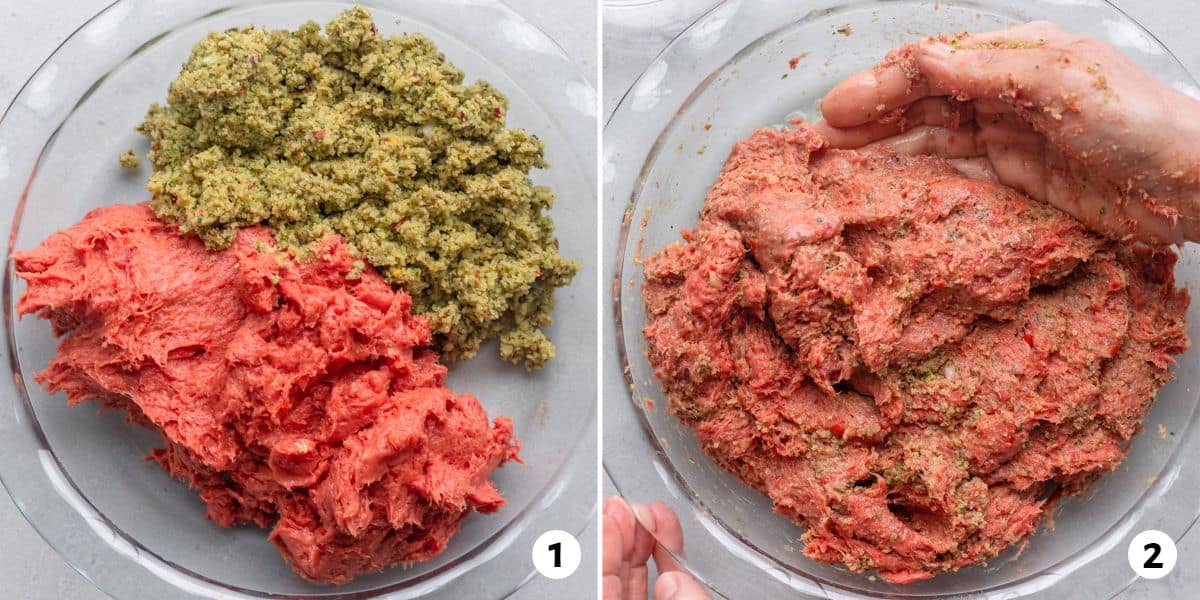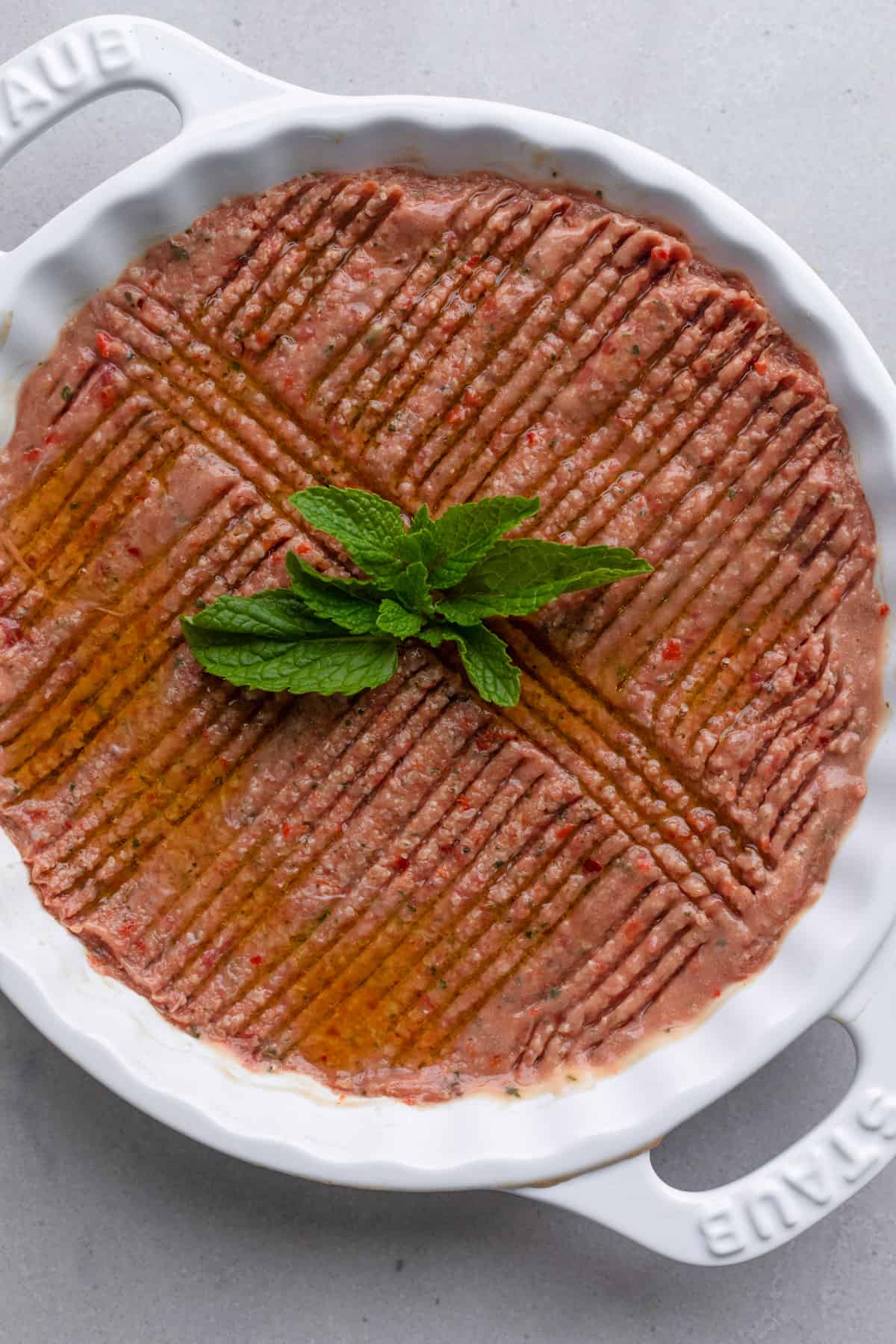This post may contain affiliate links. Please read our disclosure policy.
Kibbeh Nayyeh is a delicacy in Lebanese cuisine that is made of raw beef or lamb mixed with bulgur and spices. There are many different ways to make Kibbeh Nayyeh, but this is a Lebanese version I learned from my parents that is actually easier to make than you’d think! I grew up eating raw kibbeh during special occasions, drizzled with olive oil and scooped up with pita.
I was always intimidated to learn how to make it until I finally made the kibbe mix with my mom one day and realized the most intimidating part was just ordering the lean beef from the butcher!

Table of Contents
- What is kibbeh nayyeh?
- Why you’ll love this kibbeh Nayyeh recipe
- Kibbeh Nayyeh ingredients
- How to make raw kibbeh
- Tips for making the best kibbeh nayyeh recipe
- Popular substitutions & additions
- What to serve with Lebanese raw kibbeh nayyeh
- How to store Kibbeh
- Frequently asked questions
- More Lebanese beef recipes:
- Kibbeh Nayyeh Recipe
There are a few different types of kibbeh, and there are different ways to prepare the mixture of beef with bulgur and spices ranging from Kibbeh in Yogurt Sauce to Fried Kibbeh Balls (stuffed with ground beef and onions) to Baked Kibbeh.
What is kibbeh nayyeh?
Kibbeh Nayyeh is similar to all those versions of cooked kibbeh in making the beef and bulgur paste, but the “nayyeh” translates to raw. The funny thing is I grew up eating this and not knowing it was raw beef until I was 11 years old. Now I enjoy it during special occasions, mostly just when my mom makes it for my dad.
Why you’ll love this kibbeh Nayyeh recipe
- Authentic recipe. This raw meat dish is a traditional Lebanese family recipe passed down for generations. My mom learned it from her mom, who’s been making it for decades. It’s the real deal!
- Minimal ingredients. To make it, you’ll need 100% lean beef from your local butcher, along with bulgur wheat and a special blend of aromatic spices. Red pepper and onion are also added to the mix to take the dish to the next level. With only a few ingredients, Kibbeh nayyeh is still a perfect balance of flavor and texture.
- Unique dish to try. If you enjoy eating carpaccio, Kibbeh nayyeh is a must-try dish. Like carpaccio, Kibbeh nayyeh is made with finely ground raw beef, giving it a delicate texture that melts in your mouth.
Kibbeh Nayyeh ingredients
- Beef: This is not the type of beef you want to buy at a grocery store. Think of it like sushi-grade fish. You need the highest quality raw fresh beef, and we always get it from a butcher for that reason.
- Red Pepper + onion: Blending the vegetables into the meat mixture adds a slightly sweet and peppery flavor from the red pepper and a sharpness from the onion. These flavors work together to complement the savory beef, resulting in a delicious and satisfying dish.
- Butter: Butter adds flavor and a smoother texture to this raw beef dish. Use unsalted for better control of the saltiness.
- Bulgur: Opt for fine #1 bulgur that doesn’t require any cooking. You just need to soak it in water to plump it up.
- Fresh herbs: The crisp flavors of mint and basil are perfect for contrasting all the richness of the raw beef and bulgur mixture.
- Spices: Kamouneh spice mixture, and salt. The kamouneh spice mixture is made up of cumin seeds, rose petals, mint and basil leaves, and pepper. This is where all the flavor comes from, and every spice mixture is a little different. This can be hard to find outside Middle Eastern stores, so you can make your own with the ingredients listed above.

How to make raw kibbeh
Using a food processor is a quick and easy way to blend the raw beef and bell pepper into a smooth meat paste for kibbeh nayyeh. Plus, when mixing the bulgur mixture, you can skip the step of washing the bowl of the food process beforehand, which makes this recipe a breeze and easy to clean up.
How to make Lebanese raw meat in a food processor
- Place the beef, red pepper, butter, and salt in the bowl of a food processor.
- Blend until the meat forms a dough ball. While blending, stop and scrape down the sides to make sure all the beef chunks turn into ground meat and the peppers are chopped finely. Transfer the beef mixture to a bowl and store it in the fridge while you prepare the kamouneh mixture.
- Immediately add the soaked bulgur, onion, kamouneh spice, and herbs to the same food processor. If you’re not making this step right after the meat, then make sure you clean the equipment first. Otherwise, you will not need to wash it as you mix these two parts.
- Blend the bulgur mixture until the onions are chopped into small pieces, and everything is well combined.

Combine the beef and bulgur mixture
- Remove the meat paste from the fridge and add your bulgur kamouneh mixture on top. The trick to mixing the meat and adding moisture is to wet your hands before starting and then continue to wet them while kneading them both together.
- Keep kneading until it’s well combined and smooth. Once it’s all mixed, transfer it to a serving dish, and you can use the back of a fork to make decorative lines – perfect for catching the olive oil.

Tips for making the best kibbeh nayyeh recipe
- Buy the meat the same day you make the recipe. Because the beef is raw, it’s important for it to be fresh. Avoid buying it from a grocery store and go directly to a butcher you trust.
- Work fast. Again, because you’re working with raw meat, you want to make sure you’re not handling the beef for too long to remain safe. Knead the dough quickly and store it in the fridge when you’re preparing other parts of the recipe.
- Work in batches. Depending on how large your food processor is, you may need to grind the meat in batches in order to create a paste from the beef chunks. It’s faster to do it in two batches, but it’s convenient if you can fit it all into one large food processor.
- Keep processing until it forms a ball. Just like making bread dough, you’re looking for the mixture to form a dough ball essentially in the food processor. This is your cue that the meat is finely minced and ready to be mixed with spices and herbs.
- Use extra virgin olive oil for serving. Although it’s not an ingredient needed to make the recipe, it’s essential for serving the kibbeh the authentic way. High-quality extra virgin olive oil will really bring out the flavor of the dish.
Popular substitutions & additions
- Use lamb or veal. It’s very common to use lamb or veal with or instead of beef when making any of the different types of kibbeh, including this raw version. The recipe works the same way.
- Switch out the herbs and spices. I think the most important here are dried mint, cumin seeds, and peppercorns, but you can also use other dried herbs, other warm spices like cinnamon and allspice, and other types of dried pepper. Try to stick to about ¼ cup of the mixture, though, especially since you’re looking for whole herbs and spices, not ground spices.
- Use different onions and peppers. Red pepper adds sweetness, but you could use any color. Green bell peppers are a little more bitter, so they will alter the flavor a bit. If you want a sharper onion flavor, you could use red onion or another onion variety.
What to serve with Lebanese raw kibbeh nayyeh
- Homemade Pita Bread
- Vegetables like radishes, cucumbers, bell peppers, white onions, and spring onions.
How to store Kibbeh
It’s best to enjoy this within 24 hours since it’s raw. But if you have leftovers after that time, you can form them into small meatballs or kibbeh balls and fry or bake them.
How long will Lebanese raw meat last in the fridge?
It should only be stored in the fridge for a few hours before eating. If making it into a cooked recipe, use it by the next day.
Can I freeze kibbeh nayyeh?
Yes, you can freeze it, though the beef should be cooked after thawing as it wouldn’t be as good or safe to eat after freezing and thawing.
Frequently asked questions
Eating raw meat has a chance of carrying foodborne illness, so it is important to source your meat from a trusted supplier. Raw meat dishes are traditional cuisines in many cultures and use the freshest meat to prepare them.
Regardless of the method, raw meat can pose a higher risk of foodborne illness for certain groups, such as young children, pregnant women, and individuals with weakened immune systems. Seek advice from a healthcare professional or a food safety expert before consuming raw meat to ensure that the risks are fully understood and minimized.
Kibbeh Nayyeh is typically made with raw beef or lamb that is finely ground. The meat should be lean and fresh, as it will be consumed raw. Some people like to mix both types of meat together for a more complex flavor
Kibbeh Nayyeh is usually served as an appetizer alongside pita bread, fresh herbs, and raw onions. Some people also like to add a drizzle of olive oil or a sprinkle of sumac on top for extra flavor.

Kibbeh nayyeh is a unique and delicious dish, it’s a staple in Lebanese cuisine, and despite it being raw beef, it’s a delicacy that many enjoy during special occasions. The thought of making a raw meat dish may seem daunting, but anyone can make it at home with the right ingredients and equipment. Try this traditional and authentic Lebanese kibbeh nayyeh recipe and impress your guest with a delicious dish.
More Lebanese beef recipes:
- Meat Stuffed Pitas
- Kibbeh in Yogurt Sauce
- Lebanese Kibbeh Balls
- Lebanese Ground Beef (Hashweh)
- Baked Kibbeh
- Beef Kafta
- Kafta and Potato Stew
- Hummus With Ground Beef
- Mediterranean Ground Beef and Rice
If you try this feel good Kibbeh Nayyeh recipe or any other recipe on Feel Good Foodie, then don’t forget to rate the recipe and leave a comment below! It helps others who are thinking of making the recipe. We would love to hear about your experience making it. And if you snapped some shots, share it on Instagram so we can repost on Stories!

order MY book
The Feel Good Foodie Cookbook is now available everywhere books are sold!
Amazon TargetBarnes & Noble Books A Million Hudson Booksellers BookshopSCHULER Books

Kibbeh Nayyeh
Ingredients
- 1 cup fine #1 bulgur wheat
- 1 cup water plus more for shaping
- 1 pound 100% lean beef
- 1 red pepper seeded
- 4 tablespoon unsalted butter
- 2 teaspoons salt
- 1 small onion quartered
- ¼ cup kamouneh spice mixture
- ¼ cup packed fresh basil
- ¼ cup packed fresh mint plus more for serving
- Olive oil for serving
Instructions
- Place the bulgur and water in a small bowl and all the bulgur to soak for 15 minutes. The water should all be absorbed. Fluff the bulgur with a fork
- Place the beef, red pepper, butter and salt in the bowl of a food processor. Blend until the meat forms a dough ball, stopping to scrape down the food processor as needed, about 5 minutes. Remove the mixture from the food processor and place it in a large shallow bowl in the fridge while you prepare the kamouneh mixture.
- In the same food processor used to make the meat paste, add the soaked bulgur, onion, kamouneh spice, basil, mint and. Blend until well combined.
- Transfer the bulgur kamouneh mixture on top of the meat paste, wet your hands with cold water and knead the kamouneh mixture into the beef until well combined. Continue to add water to your hands while kneading until everything is well combined and smooth to form the kibbeh, about 5 minutes.
- Transfer the kibbeh to a serving dish and spread it out to cover the surface of the plate. You can use a knife or fork to make designs across the kibbeh.
- Garnish it with fresh mint, drizzle olive oil and serve with pita bread.
Equipment
Notes
- Buy the meat the same day you make the recipe. Because the beef is raw, it’s important for it to be fresh. Avoid buying it from a grocery store and go directly to a butcher you trust.
- Work fast. Again, because you’re working with raw meat, you want to make sure you’re not handling the beef for too long to remain safe. Knead the dough quickly and store it in the fridge when you’re preparing other parts of the recipe.
- Work in batches. Depending on how large your food processor is, you may need to grind the meat in batches in order to create a paste from the beef chunks. It’s faster to do it in two batches, but it’s convenient if you can fit it all into one large food processor.
- Keep processing until it forms a ball. Just like making bread dough, you’re looking for the mixture to form a dough ball essentially in the food processor. This is your cue that the meat is finely minced and ready to be mixed with spices and herbs.
- Use extra virgin olive oil for serving. Although it’s not an ingredient needed to make the recipe, it’s essential for serving the kibbeh the authentic way. High-quality extra virgin olive oil will really bring out the flavor of the dish.
Nutrition
Nutrition information provided is an estimate. It will vary based on cooking method and specific ingredients used.






Love raw kibbeh, I also make it using top round roast, 3 pds grounded 3 times- perfect for that recipe. The rest i make into meat sauce for pastas. The family loves it – also baked.
Love that! Yeah, it’s super versatile!
First time I hear kibbeh nayyeh with bell pepper and butter! I am reluctant to try as these two ingredients will change the taste of the kibbeh.
The red pepper just makes the color brighter and gives it a subtle sweet pepper taste and the butter gives it better texture and more creaminess. You can leave out those two ingredients but it’s the way my mom makes it and how I grew up having it.
She sure is advocating just that. It’s regional and the recipes are personal to families, but this is the same dish that my grandmother taught me to make more than 60 years ago. It’s been on our table at every special occasion (and sometimes just because we feel like it) for more than a century — and long, long before that in the old country. My brother-in-law refused to even sample it until he was about 50 years old and his own kids dared him to try it. Now, he fancies himself quite an expert on it. Poor guy doesn’t know what goes into making it, but he mooches around the kitchen “testing” it, getting in our way, when it’s on the menu. There’s steak tartare, sushi, carpaccio and lots, lots more.
Lol you gotta love when the men push into the kitchen to sample everything!
Are you really advocating eating raw beef???? Did I miss something here?
Many cultures and cuisine use raw beef in recipes. For instance, steak tartare is a classic. It is not for everyone, and I do recommend getting the beef from a reputable butcher, not from the grocery store.